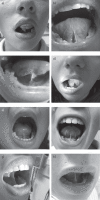A frequent phenotype for paediatric sleep apnoea: short lingual frenulum
- PMID: 27730205
- PMCID: PMC5034598
- DOI: 10.1183/23120541.00043-2016
A frequent phenotype for paediatric sleep apnoea: short lingual frenulum
Abstract
A short lingual frenulum has been associated with difficulties in sucking, swallowing and speech. The oral dysfunction induced by a short lingual frenulum can lead to oral-facial dysmorphosis, which decreases the size of upper airway support. Such progressive change increases the risk of upper airway collapsibility during sleep. Clinical investigation of the oral cavity was conducted as a part of a clinical evaluation of children suspected of having sleep disordered breathing (SDB) based on complaints, symptoms and signs. Systematic polysomnographic evaluation followed the clinical examination. A retrospective analysis of 150 successively seen children suspected of having SDB was performed, in addition to a comparison of the findings between children with and without short lingual frenula. Among the children, two groups of obstructive sleep apnoea syndrome (OSAS) were found: 1) absence of adenotonsils enlargement and short frenula (n=63); and 2) normal frenula and enlarged adenotonsils (n=87). Children in the first group had significantly more abnormal oral anatomy findings, and a positive family of short frenulum and SDB was documented in at least one direct family member in 60 cases. A short lingual frenulum left untreated at birth is associated with OSAS at later age, and a systematic screening for the syndrome should be conducted when this anatomical abnormality is recognised.
Conflict of interest statement
Conflicts of Interest: None declared.
Figures


References
-
- Guilleminault C, Akhtar F. Pediatric sleep-disordered-breathing: new evidence on its development. Sleep Med Rev 2015; 24: 46–56. - PubMed
-
- Guilleminault C, Abad VC, Chiu HY, et al. . Missing teeth and pediatric obstructive sleep apnea. Sleep Breath 2016; 20: 561–568. - PubMed
-
- Lee SY, Guilleminault C, Chiu HY, et al. . Mouth breathing, nasal “disuse”, and pediatric sleep-disordered breathing. Sleep Breath 2015; 19: 1257–1264. - PubMed
-
- Messner AH, Lalakea ML, Aby J, et al. . Ankyloglossia: incidence and associated feeding difficulties. Arch Otolaryngol Head Neck Surg 2000; 126: 36–39. - PubMed
LinkOut - more resources
Full Text Sources
Other Literature Sources
